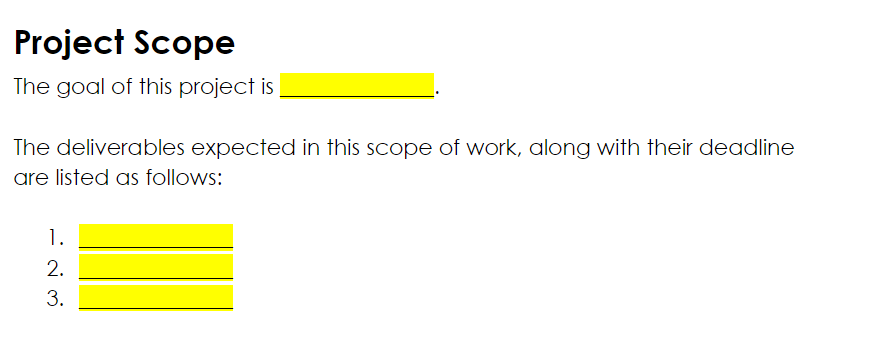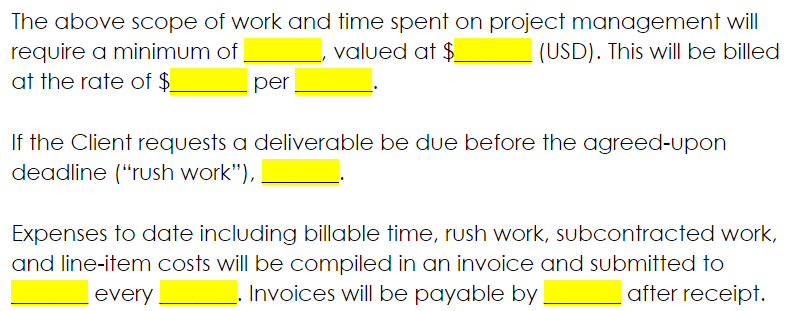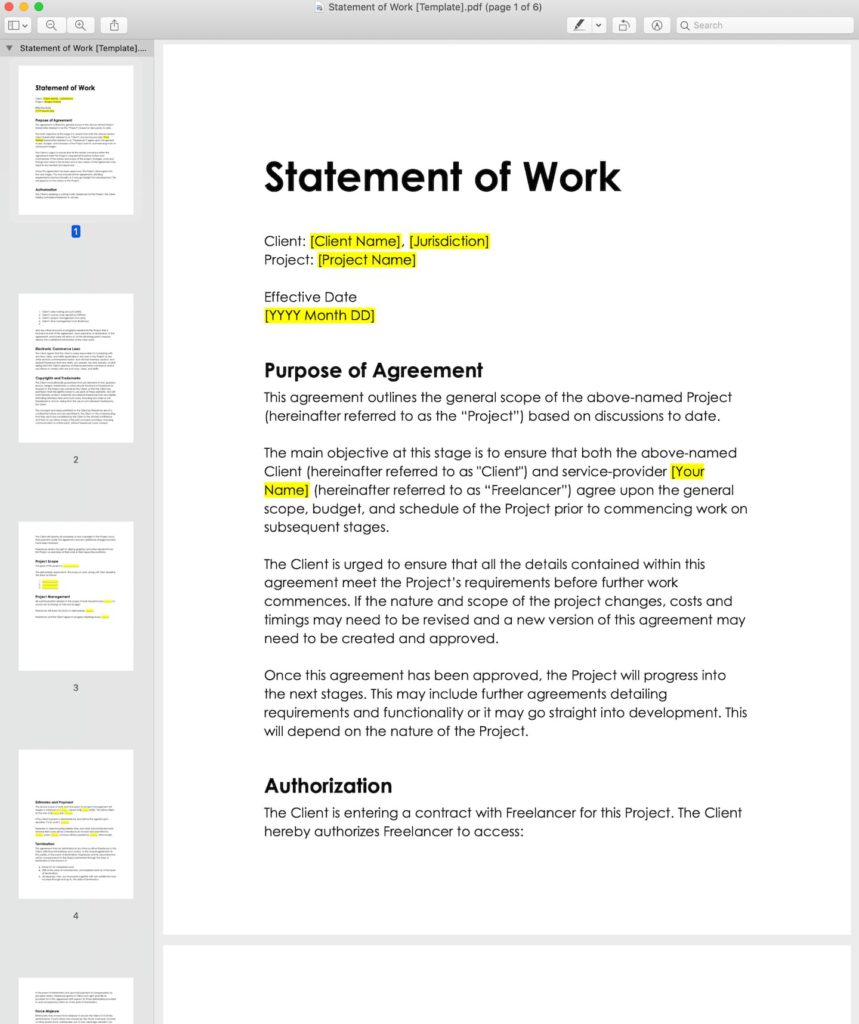No matter how massive or how simple, when entering into a contract with another business, a statement of work will be the initial binding guarantee and outline of how the work will meet established guidelines, standards, and expectations.
Because statements of work are detailed and thorough, creating one can seem a bit overwhelming. It may require employing certain tools – such as the best time tracking software, for example. To help, we’ve broken down the details for you and put together this simple, easy-to-follow guide to the ins and outs of creating a statement of work.
The FREE template you can find below 👇👇👇
What is a Statement of Work (SoW)? Understanding the Basics
A statement of work or SoW is a contract setting up the expectations for the project and aligning the team(s) involved. Details should clarify the price, timeline, deliverables, process, expectations of requirements, invoicing schedules, and much more, depending on the scope and breadth of your project.
Put simply, SoW is a document of agreement between a client and agency defining the details of what the project will include and what it won’t.
A statement of work is among the first documents you’ll put together to assemble the framework of a project before entering the planning and execution stages. In essence- it’s the first detailed overview of your project.
Why a statement of work is crucial for project success
Ultimately, a statement of work is about managing and documenting expectations. The guidelines laid out in the statement of work provide clarity, and detail, and will make sure everyone’s on the same page, avoiding conflict within the workings of the project. The sides and parties who should receive a statement of work are:
- The project leader will need the statement of work since it captures and defines every detail of building and maintaining the project.
- Contractors or collaborators outside your organization will use the SoW as a detailed compass for navigating the terms, deliverables, work details, schedules, and expected outcomes.
- Everyone involved with the contract, regardless of whether they’re bound and contracted. For instance, contractors who are still bidding on the project, or even vendors looking to contribute with product/services you may need to utilize. You may want to make sure that they understand and acknowledge the guidelines laid out in your SoW.
Statement of Work vs Scope of Work, Project Charter & Master Services Agreement
We’ve found that these terms are easily confused, or they’re used interchangeably (incorrectly), so we thought we’d include a short section here clarifying the differences.
Statement of work vs. scope of work
If you are wondering what the difference is between a scope of work vs. a statement of work, it’s pretty simple:
The statement of work is an all-encompassing, detailed document outlining the goals, purpose, guidelines, deliverables, time requirements, costs, etc.
The scope of work is one section within the SoW describing in detail the projected outcomes of the project and the specifics about the job done to hit those outcomes.

Outlining the project scope helps nail down the project’s direction and make sure it stays rooted to its original goal. Projects will invariably change some, but a scope of work helps ensure that change doesn’t deviate too far from the path or grow out of control. You’ll find the scope of work detailed out more when we examine the SoW outline.
Statement of work vs. project charter
The difference between a project charter and an SoW is that the project charter confirms authorization of the project, and contains the scope of work within it. In contrast, a project charter is a short, formal document confirming approval to start or continue a project. It’s usually drawn up after review by an investor or project initiator, and it states the purpose and key elements of the project. Learn more about a project charter and what it can do for you.
Statement of work vs. master services agreement (MSA)
An MSA covers a mutually consensual contract outlining the terms that govern future agreements or transactions between an agency and a client. The MSA’s purpose is to bind the parties involved to some simple terms in order to expedite the agreement of any future transactions quickly. The MSA should include and define as many terms as possible as generically as possible to avoid the need for repeated renegotiation so that all parties can better focus on the details.
3 Different Types of SoW
The basic types of statements of work fall mainly into 3 categories:
1. Design/detail
This type of SoW outlines the buyer’s expectations and requirements for the flow of the project and is put in place to tell the supplier how the work’s completion should meet those expectations. Examples of these requirements could include quality control, measurements, materials, etc. The most critical point of this type of SoW is to make clear that since the contractor is required to follow the buyer’s explicit requirements rather than its own, the buyer bears the risk of performance.
Using a requirements-gathering template for this type of SoW is key, as it ensures communication regarding any questions and answers about the buyer’s requirements (a measurement of materials, quality, and requirements for the supplier’s process, just to name a few).
2. Level of effort/time and materials/unit rate
This type of SoW is a kind of one-size-fits-all version and focuses on the deliverables of work hours, as well as defining the materials required to complete the project.
3. Performance-based
This SoW defines the conditions of contracts measured on a performance-based work structure, including equipment supplied and the purpose of the work performed:

The method of completion of the work is unspecified, giving the project manager the autonomy to decide how to complete the project successfully.
Step-by-Step Guide to Writing an Effective Statement of Work
Since it captures and defines every detail of your project, it’s imperative that your statement of work is thorough and accurate. At the same time, it’s a good idea to keep it short and detailed to make it easy to follow. Sounds tough? Worry not! Here’s how to make it right:
- Break up the project into phases. This way, you can get an idea of what each stage requires as you go, along with what SoW has to contain within each phase.
- Define your goal and how you’re going to reach it. Present a detailed outline of deliverables. Then what it’s going to take to produce those deliverables? Expand on not only what is within the scope of the project, but what may be outside of it as well.
- Explain the purpose of your project in a way that will be crystal clear to all involved. The plan itself may be a dynamic process, but your clear, concise purpose won’t. This is the benchmark on how you’ll measure the project’s success.
- Set clear, simple, quantifying boundaries, so all parties understand the expectations of project completion.
- Based on the four points above, our scope of the project statement is to mutually determine expectations of the project’s range of requirements within the tasks of the project.
- Make it short and sweet but still clear enough that there’s no room for misinterpretation.
- Educate and validate! Make sure you know your SoW inside out. This way, your team, your client, and whoever else is on a need-to-know basis understands it too. Best practice: check-in throughout the project and provide bullet reminders of pertinent points to keep everyone on track.
- USE A PROJECT MANAGEMENT TOOL! A good project management tool is a game-changer. It ensures you have all t’s crossed and i’s dotted in your SoW.
🎓 PRO TIP: If possible, include a work breakdown structure in your SoW. It is super useful for breaking down larger projects into more manageable chunks. Consider using project management software to manage, organize, and track your tasks and their respective sub-tasks.
Using Everhour as an example, you can break down the budget spent by individual task, project phase, and even employee. Employees themselves can have a blanket hourly rate, or a specific project rate — making it easy to account for any external contractors you bring into your team. For longer projects and retainers, there’s also an option to track recurring budgets.
Statement of Work Outline
As with finishing any large task- breaking down a statement of work into detailed bits makes it infinitely easier to complete. The parts of your SoW will be proportionate to the size of your project. Let’s get into the major points of the project it should touch on.
✔️ Introduction
The introduction gives a general explanation of the work and who is involved in the project. A standing offer will follow (a commitment to the project). This locks in the cost of products and/or services needed for the project. It also paves the way for a more formal, detailed contract.
✔️ Project purpose
This portion of the SoW describes the purpose of doing the project. What is it for? Why do you want to initiate the project? Be sure a strong purpose statement starts off the project purpose section and provides detailed answers to questions about objectives, deliverables, and returns on investment.
✔️ Scope of work
Here you’ll find detailed information on further completion of the project. You’ll include an outline detailing the required work, the processes used to complete the job, what time frame it will take to complete the project, and the utilization of resources to complete the project, such as tools, software, hardware, etc.
✔️ Where will the work be done?
Specify the project site if your team will be working from a central location, or details about the circumstances if they’re working remotely. No matter where your people are working, communication detailing their location, as well as any tools used on location is imperative. (Software, equipment, etc.)
✔️ Break down the steps outlined in the scope of work section into detailed tasks
This is the place to make sure your steps are clear and detailed, as laid out in the scope of work. Things like the specific work needed, processes to achieve completion, how long it will take to complete the project, and the required purchasable resources to complete the project.
Remember, breaking up each of these categories into phases or milestones will make it much easier to create detailed, quantifiable plans for each. to make sure everyone understands what it will take to complete each phase of the project.
✔️ Create measurable milestones
Layout clearly how much time is available and scheduled to complete the project from beginning to end. Agree on a start date and a proposed finish date, then make sure detailed billable hours by day, week, month are available. This includes hours spent on detailing and recording billable hours and schedules!
Make any maximum amounts for billable hours for contractors and/or vendors clear here as well. This is the part where we’re dabbling in people’s paychecks- so specificity is paramount here.
✔️ What are the deliverables?
Make a list of deliverables along with a clear, agreed-upon explanation of what is due and when. Details related to the “finished product” are helpful here- quantity, color, size, structure, etc. Whatever is required to satisfy the expectation of deliverables, be it physical, visual, or whatever – agree on its details and when it’s due.
✔️ Scheduling
This section includes a detailed list of the anticipated schedule for each and any parties involved in the project and begins with the expected completion of deliverables. The details of which vendor, contractor, etc. will hold responsibility for this when it will begin, the performance period, the development phase, the review phase, the implementation phase, the testing phase, and the timing of the close of the project. Depending upon the specifics of the project, there may be more or fewer scheduling phases.
✔️ Standards and testing
Define and list the industry standards required if applicable, as well as any adherence to testing requirements. Make it detailed. What do the standards clearly state? Measure the inventory of testing equipment, if any, and those persons involved in the testing process.
✔️ Obtain a clear definition of success
Define the expectations of the stakeholders involved in this project. What would they define as the successful completion of the project? Make sure this is clear to all parties.
✔️ Misc. requirements
Will anyone need to travel for this project? Detail that here. List any certifications or educational degrees required for the successful completion of the project (if any), and be sure to list specifically any equipment or resources needed.
✔️ Payments
Once the project budget is created- list and agree on the payment amounts, schedule of payments related to the project, and whether are payouts delivered upon completion or up-front. Will payment occur per milestone? Whatever payment plan suits the needs of all parties of the project requires agreement here.
✔️ Other, misc.
Every project is different, and they don’t usually fit neatly in a box wrapped up with a bow. There are almost always ancillary details that don’t fall into the categories listed above. This section is the place to list them in detail. Examples of these could include budgets for travel pay, details around security, protection of proprietary information, etc.
✔️ Closure
This piece is just as it says: final determination of the deliverables. Including the conditions of their acceptance, responsibility for the quality of deliverables, and determining involvement in delivery, review, and approval. The closure also includes an agreement by all parties regarding the final administrative duties. This ensures the project is approved, officially closed and archived.
Statement of Work Templates
An SoW template can be a lifesaver when it comes to designing and writing out a complete statement of work. The process is time-consuming! Because of the amount of detail it needs to include, using even a simple statement of work template will help you avoid leaving anything out.
Click one of the links below to download a free, simple, easy-to-use SoW template. Our template is basic, providing the broad points an SoW should cover. This gives you the freedom to tailor it to the needs of your business. Also, it excludes those things you may not need.
The template will walk you through each step, making the process of creating the SoW faster and easier. It also documents the specifics of dates and timelines, helping your team stay on task. Reach your project goal successfully:
Here’s the link: Statement of Work Template

Frequently Asked Questions
-
Is a statement of work a contract?
Not by itself. It’s a document within the contract or part of a project’s contract laying out the landscape of the project. -
Is a statement of work a legal document?
Yes- since it’s within the contract, it’s a legally binding document. -
Who creates the statement of work?
The SoW passes through a few hands during its creation: A coordinator plans the categories that are to be included in the SoW. Next, an author(s) devise a draft. The SoW is then passed to a reviewer(s) who provides comments and potential changes needed. The editor coordinates with the reviewers to analyze their insights. He or she then either incorporates them into the SoW or disregards them depending upon the consensus. The final version of the document is then signed by both parties and passed on for implementation.
A Few Final Thoughts
It really can’t be overstated how important it is to draft a clean, quality statement of work for any project. Set yourself up for success! First, understand what an SoW is. Next, what kind of SoW is right for your specific needs? Finally- understand how to follow the steps and the outline thoroughly. Using a template ensures you’ll get it right, and will help you reach your project’s goals.
If you are managing a team of 5 or more and looking to boost efficiency, Everhour is the perfect tool to keep your team on track. With seamless time tracking, you can easily estimate task durations, set clear budgets, and generate detailed reports inside Asana, Trello, Jira, or any other pm tool.

